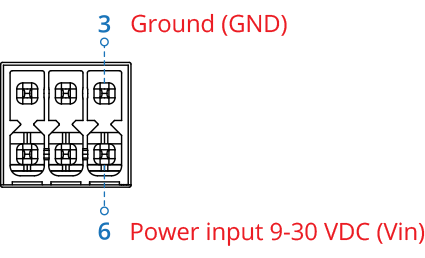TRB145 Powering Options
This chapter contains information on powering options supported by TRB145 devices.
Power socket
The TRB145 device can be powered over the 4 pin connector using a 9-30 VDC power supply unit (PSU). Refer to the image below for the power socket pinout information:
If you decide not to use the standard 9 VDC PSU and want to power the device from a higher voltage, please make sure that you choose a power supply of high quality. Some power supplies can produce voltage peaks significantly higher than the declared output voltage, especially during connection and disconnection.
While the device is designed to accept input voltage in the range of 9-30 VDC, high voltage power supplies can harm the device. If you want to use high voltage power supplies it is recommended to also use additional safety equipment to suppress voltage peaks from the power supply.
Suggestion: If you're using a different power supply than the one included in the standard packaging, make sure it meets the same power (W) specifications as the original. Otherwise, some features of the device might not work properly. Please refer to the device's portfolio page to verify the power supply specifications: Power Consumption
RS485
You can also power the device over the RS485 connector. In order to do so, follow the steps described below.
- Unscrew the two hex bolts and remove the back panel.

- Remove the PCB board from the case.
- Solder a 0 Ohm resistor or 2 pin header with jumper between the "RS PWR ENABLE" pins (marked 1 & 2 in the figure below) on the PCB board:

- Connect pins 3 (GND) and 6 (PWR) to a 9-30 VDC power supply.

- If the PWR LED lights up, the device was successfully powered over the RS485 connector.
Ground loops
Do not connect the power supply negative terminal of our device to the chassis or earth exclusively.
This connection could cause ground loops. For example, if the antenna shield and power supply negative terminal are connected to the chassis or earth, it forms a ground loop, therefore unwanted current could flow through a device PCB ground and may cause damage.


